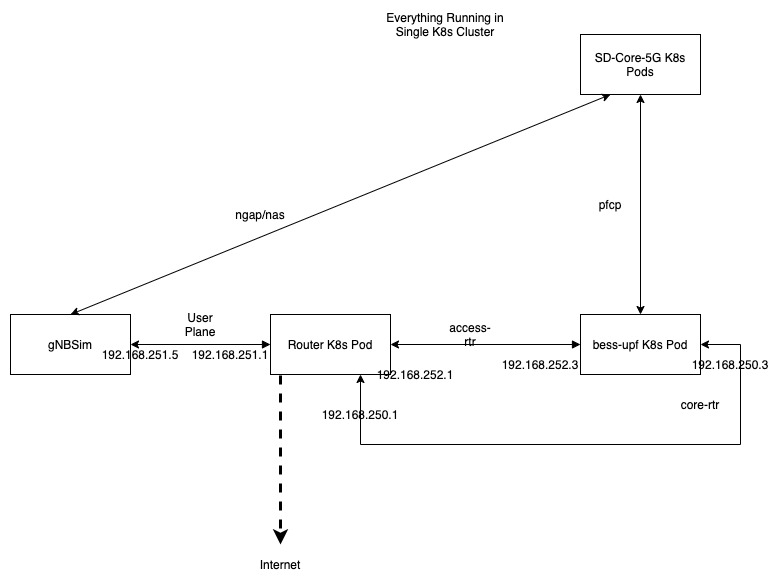gNBSim Deployment Guide
gNBSim in AIAB mode with 2 interfaces
This is default mode of deployment for gNB Simulator
Multus cni needs to be enabled on cluster. Required for bess-upf & gNBSim
make 5gc will by default deploy gNB Simulator in this mode
One interface is used for user plane traffic towards UPF
Second interface is used to send traffic towards control plane (i.e. AMF).
UPF network & default gateway is provided in the override values.
Route to UPF network is added when POD comes up
defaultAs is configured per profile. This address is used to send data traffic during test
Note
Multiple gNB’s in one simulator instance need more changes in helm chart. This is pending work.
To add UPF routes. Following is example of override values
config:
gnbsim:
gnb:
ip: 192.168.251.5/24 #user plane IP at gnb if 2 separate interface provided
singleInterface: false
networkTopo:
- upfAddr: "192.168.252.3/32"
upfGw: "192.168.251.1"

gNB simulator running standalone with single interface
Install gNB Simulator on any K8s cluster
Multus cni needs to be enabled for the K8s cluster where bess-upf runs
Make sure gNB Simulator can communicate with AMF & UPF
TODO - New Makefile target will deploy just 5G control plane
TODO - New Makefile target will deploy only gNB Simulator
Single interface is used for user plane traffic towards UPF & as well traffic towards AMF
defaultAs is configured per profile. This address is used to send data traffic during test
configure AMF address or FQDN appropriately
Note
Multiple gNB’s can not be simulated since only 1 gNB will be able to use 2152 port
Following is example of override values
config:
gnbsim:
singleInterface: true
yamlCfgFiles:
gnb.conf:
configuration:
gnbs: # pool of gNodeBs
gnb1:
n3IpAddr: "POD_IP" # set if singleInterface is true

gNBSim running standalone with 2 or more interfaces
Install gNB Simulator on any K8s cluster
Multus cni needs to be enabled on cluster. Required for bess-upf & gNB
Make sure gNB Simulator can communicate with AMF & UPF
TODO - New Makefile target will deploy just 5G control plane
TODO - New Makefile target will deploy only gNB Simulator
One interface is used for user plane traffic towards UPF
Second interface is used to send traffic towards control plane (i.e. AMF).
UPF network & default gateway is provided in the override values.
Route to UPF network is added when POD comes up
defaultAs is configured per profile. This address is used to send data traffic during test
configure AMF address or FQDN appropriately
Note
Multiple gNB’s in one simulator instance need more changes in helm chart. This is pending work.
To add UPF routes. Following is example of override values
config:
gnbsim:
gnb:
ip: 192.168.251.5/24 #user plane IP at gnb if 2 separate interface provided
singleInterface: false
networkTopo:
- upfAddr: "192.168.252.3/32"
upfGw: "192.168.251.1"

Running gNBSim Standalone Application in or out of a Docker

Note that DATA-IFACE is ens1f0, this interface to be used for both control and data traffic
- We need two VMs, in this example we call one is SD-Core VM, other one is Simulator VM
SD-Core VM: to Deploy AIAB
Simulator VM: to Run gnbsim process in or out of Docker
SD-Core VM Preparation:
To Expose External IP and Port of amf service, update sd-core-5g-values.yaml
amf: # use externalIP if you need to access your AMF from remote setup and you don't # want setup NodePort Service Type ngapp: externalIp: <DATA_IFACE_IP> nodePort: 38412
Deploy 5g core with options DATA_IFACE=ens1f0 and ENABLE_GNBSIM=false, sample command:
$ ENABLE_GNBSIM=false DATA_IFACE=ens1f0 CHARTS=release-2.0 make 5g-core
Make sure that
DATA_IFACEconnected with Simulator VM
Simulator VM Preparation
Single interface is used for user plane traffic towards UPF
Single interface is used to send traffic towards control plane (i.e. AMF).
Checkout gnbsim code using the following command:
$ git clone https://github.com/omec-project/gnbsim.git
Install ‘go’ if you want to run with local executable
$ wget https://go.dev/dl/go1.19.linux-amd64.tar.gz $ sudo tar -xvf go1.19.linux-amd64.tar.gz $ mv go /usr/local $ export PATH=$PATH:/usr/local/go/bin
To Compile the code locally, you can use below commands:
$ ``go build`` or ``make docker-build``
Add following route in routing table for sending traffic over
DATA_IFACEinterface$ ip route add 192.168.252.3 via <DATA-IFACE-IP-IN-SD-CORE-VM>
Just to Make sure the data connectivity, ping UPF IP from
DATA_IFACE:$ ping 192.168.252.3 -I <DATA_IFACE>
configure correct n2 and n3 addresses in config/gnbsim.yaml
configuration: singleInterface: false #default value execInParallel: false #run all profiles in parallel gnbs: # pool of gNodeBs gnb1: n2IpAddr: <DATA-IFACE-IP>># gNB N2 interface IP address used to connect to AMF n2Port: 9487 # gNB N2 Port used to connect to AMF n3IpAddr: <DATA-IFACE-IP> # gNB N3 interface IP address used to connect to UPF. when singleInterface mode is false n3Port: 2152 # gNB N3 Port used to connect to UPF name: gnb1 # gNB name that uniquely identify a gNB within application
configure AMF address or FQDN appropriately in gnbsim.yaml
configuration: singleInterface: false #default value execInParallel: false #run all profiles in parallel gnbs: # pool of gNodeBs gnb1: defaultAmf: hostName: # Host name of AMF ipAddr: <AMF-SERVICE-EXTERNAL-IP> ># AMF Service external IP address in SD-Core VM port: 38412 # AMF port
Run gnbsim application using the following command:
$ ./gnbsim -cfg config/gnbsim.yaml (or)Install Docker and run gnbsim inside a Docker with Docker hub Image or locally created Image
$ docker run --privileged -it -v ~/gnbsim/config:/gnbsim/config --net=host <Docker-Image> bash $ ./gnbsim -cfg config/gnbsim.yaml
Note: gnbsim docker images found at https://hub.docker.com/r/omecproject/5gc-gnbsim/tags